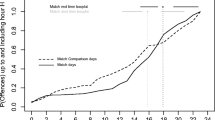Abstract
The article “Violence reduction or relocation” by Laura Peitz and Gregor Reisch examines how local variation in the presence of peacekeepers influences violence in the eastern provinces of the Democratic Republic of the Congo. This reply first discusses the authors’ contributions to existing peacekeeping literature, then highlights its practical relevance and finally suggests three avenues for future research. The first contribution is the sophisticated differentiation of peacekeeping troops by their force projection capacity, which existing quantitative research tends to ignore. The second contribution is the comparison between peacekeepers’ effects on events of armed fighting to their effects on one-sided violence against civilians, showing that unarmed observers are more successful in civilian protection than we previously thought. The third contribution is an analysis of how peacekeepers geographically shift violence away from peacekeeping bases, going beyond the conventional focus on analysing direct effects in peacekeepers’ deployment locations. Together, these insights point to at least three avenues for future research. First, the finding of spatial displacement effects calls for a re-assessment of the overall local effectiveness of peacekeeping operations in reducing violence. Second, examining how mandate modifications, especially the move to offensive peace enforcement operations, influence peacekeeping effectiveness deserves more attention. Finally, the article uses novel, spatially disaggregated data on violence and peacekeeping. Analysing these data refines our knowledge on local peacekeeping practices, but also opens room for new spatial modeling techniques and warrants careful thinking of realistic counterfactuals in order to correctly interpret the substantive effects of local peacekeeping deployment.
Similar content being viewed by others
References
Autesserre, Séverine. 2014. Peaceland. Conflict Resolution and the Everyday Politics of International Intervention. Cambridge: Cambridge University Press.
Cruz, Carlos Alberto Santos. 2017. Improving security of united nations peacekeepers: we need to change the way we are doing business. http://tiny.cc/t10ibz. Accessed 21 Aug 2019.
Dorn, Walter. 2015. Wings for peace: the four faces of air power in UN operations. Pensez les ailes francaises 33:34–45.
Fjelde, Hanne, Lisa Hultman, and Nilsson Desirée. 2019. Protection through presence: UN peacekeeping and the costs of targeting civilians. International Organization 73(1):103–131.
Howard, Lise. 2019. Five myths about peacekeeping. Washington Post. http://tiny.cc/zb1ibz. Accessed 21 Aug 2019.
Hultman, Lisa, Jacob D. Kathman, and Megan Shannon. 2013. United nations peacekeeping and civilian protection in civil war. American Journal of Political Science 57(4):875–891.
Ichino, Nahomi, and Matthias Schündeln. 2012. Deterring or displacing electoral irregularities? Spillover effects of observers in a randomized field experiment in Ghana. Journal of Politics 74(1):292–307.
MONUC. 2019. MONUC mandate. https://peacekeeping.un.org/mission/past/monuc/mandate.shtml. Accessed 7 Sept 2019.
MONUSCO. 2019. Background. https://monusco.unmissions.org/en/background. Accessed 7 Sept 2019.
Tull, Denis M. 2018. The limits and unintended consequences of UN peace enforcement: the force intervention brigade in the DR Congo. International Peacekeeping 25(2):167–190.
Author information
Authors and Affiliations
Corresponding author
Rights and permissions
About this article
Cite this article
Smidt, H. From disaggregated findings to „bigger picture“ and spatial modeling implications in peacekeeping research. Reply to „Violence reduction or relocation“ by Laura Peitz and Gregor Reisch. Z Friedens und Konflforsch 9, 203–209 (2020). https://doi.org/10.1007/s42597-019-00016-x
Published:
Issue Date:
DOI: https://doi.org/10.1007/s42597-019-00016-x




